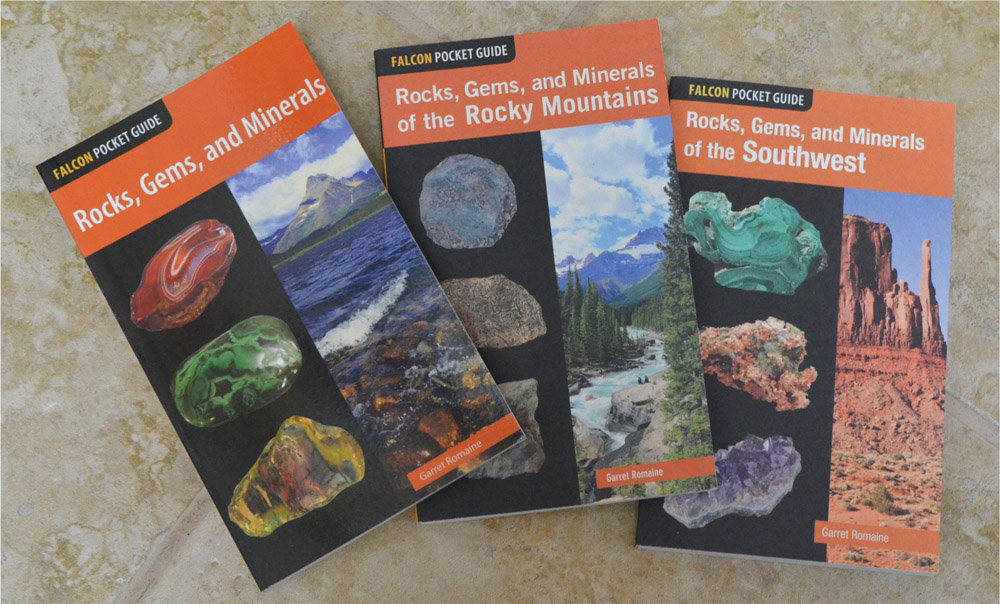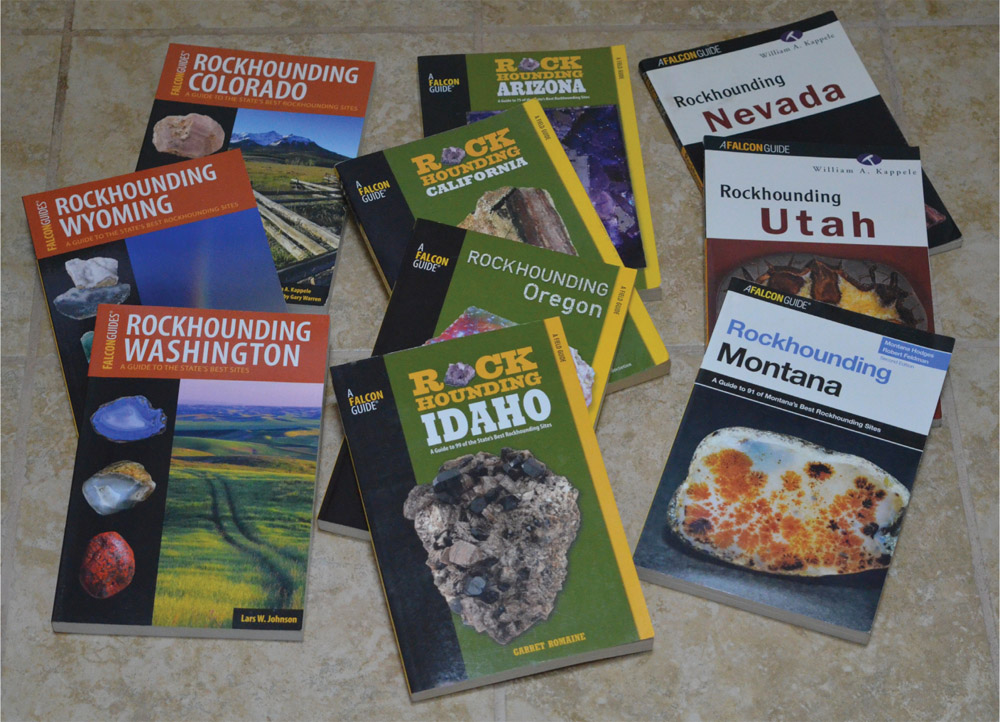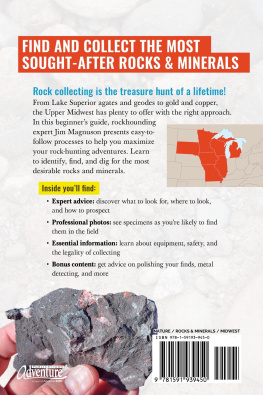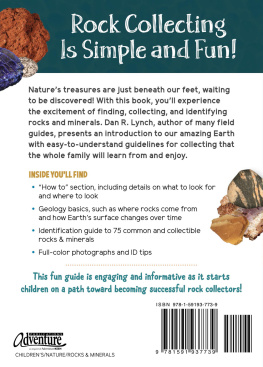
ABOUT THE AUTHOR
Garret Romaine , an avid rockhound, fossil collector, and gem hunter, is the author of numerous rockhounding guides, such as Rockhounding Idaho , Gem Trails of Oregon , Gem Trails of Northern California , and Gem Trails of Washington . He has also written three gold-panning titles: Gold Panning California , Gold Panning Colorado , and Gold Panning the Pacific Northwest . He was a columnist for Gold Prospectors magazine for fifteen years and is currently on the Board of Directors for the Rice Northwest Museum of Rocks and Minerals and the fossil-hunting organization North America Research Group.
To the grandkids:
Yamari, Osmani, and Yael, with love
FALCON
An imprint of The Rowman & Littlefield Publishing Group, Inc.
4501 Forbes Blvd., Ste. 200
Lanham, MD 20706
www.rowman.com
Falcon and FalconGuides are registered trademarks and Make Adventure Your Story is a trademark of The Rowman & Littlefield Publishing Group, Inc.
Distributed by NATIONAL BOOK NETWORK
Copyright 2019 The Rowman & Littlefield Publishing Group, Inc.
Photos by Garret Romaine unless otherwise noted
Scientific review by Julian C. Gray, Rice Northwest Museum of Rocks and Minerals
All rights reserved. No part of this book may be reproduced in any form or by any electronic or mechanical means, including information storage and retrieval systems, without written permission from the publisher, except by a reviewer who may quote passages in a review.
British Library Cataloguing-in-Publication Information available
Library of Congress Cataloging in Publication Data available
ISBN 978-1-4930-3281-5 (paperback)
ISBN 978-1-4930-3282-2 (e-book)
 The paper used in this publication meets the minimum requirements of American National Standard for Information SciencesPermanence of Paper for Printed Library Materials, ANSI/NISO Z39.48-1992.
The paper used in this publication meets the minimum requirements of American National Standard for Information SciencesPermanence of Paper for Printed Library Materials, ANSI/NISO Z39.48-1992.
Printed in the United States of America
The author and The Rowman & Littlefield Publishing Group, Inc., assume no liability for accidents happening to, or injuries sustained by, readers who engage in the activities described in this book.
INTRODUCTION
The purpose of this guide is to help you get started identifying and collecting some of the many natural treasures you will come across in the field. If youve ever picked up a pebble at the beach and wondered what it was or how it was formed, this guide can help. If you have ever visited a natural history museum and wondered how you could build your own collection, youre also in luck.
Soon you will be planning collecting trips and learning a lot more about the world around you. Thats also where this book will come in handy, because youll learn enough geology to be dangerous. Rockhounding is just a small sideshow to geology, but the better you grasp some of the basic concepts, the more efficient youll be out there in the wilds.
Think of this book as a companion for some other books by FalconGuides
If you want to take the next step up in the hobby, theres The Modern Rockhounding and Prospecting Handbook , which introduces readers to tools, software, and other resources.
If you want to learn about rocks and minerals, there is an identification guide covering important examples, plus more specific guides for particular regions.



You might also consider some of the many field guides FalconGuides publishes, such as the Gold Panning series, which covers several Western states, or the Rockhounding series, with guides to help you explore a specific state.
Many collectors start to specialize after they begin building a collection and narrow down their searches for rocks, minerals, fossils, gold, or meteorites. However, when youre first starting out, you should know a little about each of these fields. Thats where this guide will help the mostto get you started. There are some simple kitchen labs you can perform to help visualize bigger geologic processes, and there is historical information about people, referred to as Geology Giants, who make this field so much easier to understand today. Youll also get some pointers on Bucket List locations that you should plan a trip around.
All in all, you should learn about geology and the world around you, have some fun, and see some spectacular scenery along the way. Enjoy the experiences, be safe, follow the rules, and enjoy!
CHAPTER 1
GETTING STARTED
Welcome to the world of geology. This guide is aimed at everyone who is interested in learning the basics of collecting rocks and minerals, doing a little prospecting, or better understanding the geological world around them. We will start with general earth processes, mostly to give you insights into where to go and what to look for.
In this book, well assume that youre a newcomer to the terms and definitions. It may seem a bit bewildering at first. After some time, it will all start to make sense. What seems to help is to use a lot of cooking metaphors, so many of the labs will start in the kitchen. Basically, cooking is a combination of math, chemistry, and physics, so if it works in the kitchen, the same rules should apply everywhereeven on other planets.
THE THREE ROCK TYPES
Fortunately, just about everyone knows the three main rock types: igneous, metamorphic, and sedimentary. For a refresher, you can think about how rocks form and how the Earth recycles them. Lets start in the kitchen: Think of the sugar cookie dough you squeeze out of a tube or scoop with a spoon onto a greased baking sheet. The cookie dough is similar to an igneous rock that comes out of a volcano. Once you cook the dough, it changes somewhat, and its hardlike a metamorphic rock. Then, if you crumble up the cookies into crumbs, those are the same as sedimentary rocks. Now you have a metaphor for the rock cycle, straight from the kitchen. The ingredients are the same during each stage, but the chemistry changes with heat, and the amount of water vapor is the biggest variable.
Use any ingredient you likeyou can start with bakers chocolate, which, when hard, is similar to metamorphic rock. If you shave the chocolate bar with a cheese grater, you create sedimentary rock. If you melt the chocolate bar in a microwave, that turns it into melted chocolate, like hot lava. Its always nearly the same basic chemical ingredients but in three different physical forms.
To recycle the sedimentary rock, imagine the great Ring of Fire consisting of hundreds of volcanoes surrounding the Pacific Ocean. At the edge of tectonic plates that slide around at the Earths crust, you often find one plate sliding underneath the other one. The rocks that slide underneath will eventually end up so far down that there is too much heat and pressure for them to remain solid. Some material may change into a metamorphic rock as the pressure and heat cook the rock, but doing so doesnt melt it. Other times, the rocks melt into magma, and the magma wants to rise like a bubble, burning its way through the solid crust. As the plates continue to collide and more material is fed into the system, the magma blob can eventually swell up enough to break through the crust as a volcano. Alternatively, it may not break through, and instead, it freezes in place. Either way, now you have an igneous rock, and you start the cycle all over again.
Next page




 The paper used in this publication meets the minimum requirements of American National Standard for Information SciencesPermanence of Paper for Printed Library Materials, ANSI/NISO Z39.48-1992.
The paper used in this publication meets the minimum requirements of American National Standard for Information SciencesPermanence of Paper for Printed Library Materials, ANSI/NISO Z39.48-1992.

